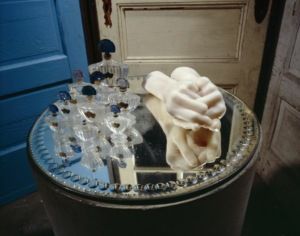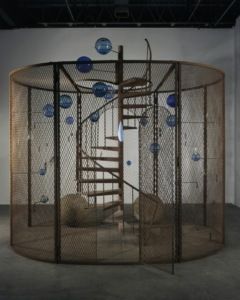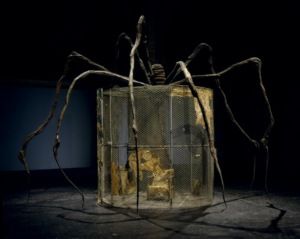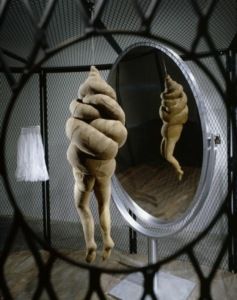Things to do
Art Review: Hailing the magic of Louise Bourgeois
This article is more than 9 years old.
Latest Louisiana exhibition a spectacular success
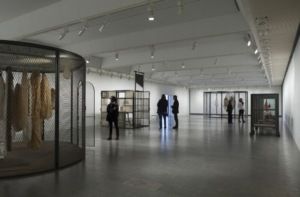
You won’t regret visiting (photo: Poul Buchard / Brøndum & Co. ©The Easton Foundation)
Once again Louisiana has come up trumps with this enchanting, engaging – and above all, thought-provoking – exhibition of the cellular installations created by Louise Bourgeois.
Nowadays, Bourgeois is considered one of the most important artists of the 20th century. No visitor to Tate Modern in London will have failed to notice her giant spider ‘Maman’. However, she really only became an international name at a relatively advanced age.
Born in France in 1911, she was active almost up until her death at 98 in Manhattan in May 2010. Whilst at the Sorbonne studying mathematics, and against the wishes of her tyrannical father, she began to study art seriously in 1935. She soon proved to be something of an individualist and, although influenced by other artists, was never a member of any particular group or school.
Large can be beautiful
Although she had been examining some of the same themes in works on paper as far back as the late 1940s, the works on display at Louisiana were a new departure for her. They came about when she was able to find studio space in a disused clothing factory in Brooklyn. The sheer size of the room enabled her to think on a much larger scale than before. There was also a wealth of material (doors, windows, shelves etc) lying around that she could incorporate into the installations. The resulting pieces were entitled ‘Cells’ and in total she created 62 of them. The current exhibition comprises 25.
All Bourgeois’s art is very much connected to her own life and reflects the traumas that she suffered as a child and adolescent. Her parents had a tapestry-restoring business and Bourgeois’ father began a long-term affair with her live-in governess right under the nose of her mother, to whom Louise was devoted. The feelings of love, anger, powerlessness, fear and neglect from that time are continually being channelled in her art.
However, although these works are intensely personal, they are also very accessible to the viewer and can be seen as a kind of diary where multiple meanings are implied by the elements used.
Structures of existence
The word ‘cell’ should be understood in the widest possible way – from those found in prison to cells within the body etc. The installations are enclosed spaces – for example by old doors, planks of wood or wire-mesh cages – which are then ‘furnished’ with a mixture of found items and her own sculpture. The viewer is able to see in through windows or other apertures in the doors, cracks between them, or though the mesh of the cages.
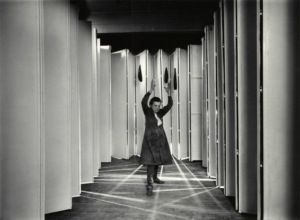
‘Louise Bourgeois inside Articulated Lair (photo: © Peter Bellamy © The Easton Foundation / Licensed by Copydan
Conditions)
Incredibly, Louise was 75 when she created the first installations in the series. Cells I-VI all date from 1991. In ‘Cell I’, which is enclosed by doors, a mattress-less bed covered with pieces of sacking can be seen. One of the sacks has the words “I need my memories. They are my documents” embroidered on it. There is also a side-table on which a large collection of glassware is assembled, comprising chemical and medical implements, suggesting illness/sanity and the different types of pain – both physical and intellectual. Also enclosed by doors, ‘Cell II’ (see below) contains a round table in the centre on which is placed a large number of empty bottles of her favourite perfume, Shalimar, and a pair of intertwined hands.
‘Cell III’ is almost labyrinthine in structure, and inside, a leg extends from a marble plinth. A side-table contains a paper-guillotine with a prone figure beside it. Is this an execution waiting to happen? This is indeed a Kafka-esque universe where nothing is strange/everything is strange. The guillotine appears again at the entrance to a later cell in which there is a model of the house where her family’s business was conducted. It seems to be being used as a metaphor to depict how the present cuts (separates) the past.
A stairway to heaven?
One of the most poignant works is the final one of the series entitled ‘Last Climb’ (see below). It is a round cage made of rusty wire-mesh with a spiral staircase situated in the middle, which continues out through the ceiling of the cage. Extending from the walls and hanging from the top of the cage are a series of hollow blue glass spheres of different sizes. There are two large wooden balls either side of the bottom of the staircase (phallic symbolism?), and near to its central pillar a cocoon-like object hangs down on a thread.
Is it too fanciful to speculate that Bourgeois was making a statement about mortality here – and her own inevitably impending death? The glass spheres seem like rising bubbles, and as for the cocoon, will a beautiful butterfly emerge from it and soar away out of the cage and into the heavens? That is for the viewer to judge. There are many interpretations possible.
Perfume and spiders
A number of elements recur in the works, amongst which are the Shalimar perfume bottles, mirrors, the cocoon (it seems to be a kind of universal figure), the spiral woman and the spider. Bourgeois associated the latter with her mother and it is used as a benign figure – above all, protective. In ‘Spider’ (below), a tapestry-covered chair is situated in a wire-mesh cage. There are fragments of tapestry on the walls, harking back to her childhood, when Louise often helped out by repairing the feet of figures on damaged tapestries. A giant spider straddles the cage, with its abdomen entering the cage at the top. It seems to be protecting the cage and its contents from harm.
I could go on – there is just so much to see and experience here. These installations represent what I like best about art; the viewer is delighted, cajoled, teased and challenged in turn, and gradually a glimpse of the inner life and soul of the artist reveals itself. In addition, there is plenty of room to allow your own imagination free rein. As Bourgeois herself said: “Art is the guarantee of sanity.”

